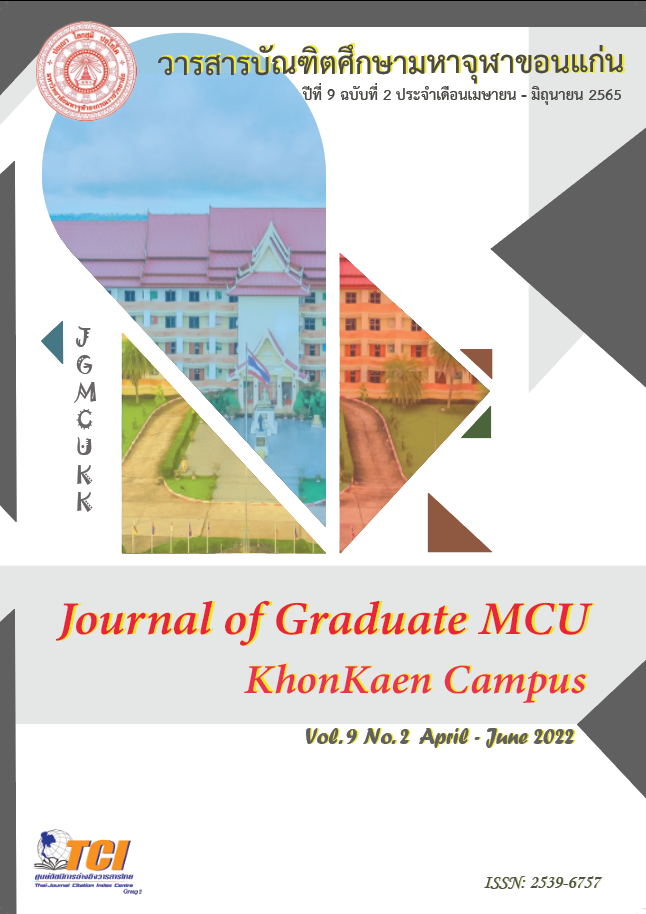The Guidelines of Monastery Management for Spiritual Tourism : A Case Study of Wat Pa Tam Wua Forest Monastery The Guidelines of Monastery Management for Spiritual Tourism : A Case Study of Wat Pa Tam Wua Forest Monastery
Main Article Content
Abstract
The objects of this research were: 1) to study the concepts and theories of monastery management for spiritual tourism in Buddhism, 2) to study and analyze the practical principles of monastery management for spiritual tourism of Wat Pa Tam Wua forest monastery, Mae Hong Son, 3) to propose guidelines of monastery management for spiritual tourism in Thailand. This research was conducted by the qualitative research method. The researcher has studied primary and secondary and conducted the fieldwork to collect the data by in-depth interviews and participant observations. Then the obtained data were analyzed and the findings were presented by the descriptive approach.
The research results were as follow: “Meditation at Monastery” in Thailand followed Buddhist principle “Trisikkha” is an attraction for spiritual tourism. By applying “the seven principles of Sappaya” in monastery managementto support meditators. Also,“Loving Kindness” that has been given to everyone, no racial discrimination. The tourists who came for spiritual practice, will have this impressive experience and learn about loving kindness. “Sangaha-Vatthu 4”principle applying in the monastery
management to develop an effective management with warm and friendly environment. The guidelines for operation are divided; 1) The operation in monasteries: the place, the people, the organizing of activities within the monastery, the plan of monastery for spiritual tourism 2) The coordination with agencies outside the monastery : the public relations of the monastery, the tourism development coordination, to create the community’s involvement in monastery management for spiritual tourism.
Article Details

This work is licensed under a Creative Commons Attribution-NonCommercial-NoDerivatives 4.0 International License.
References
กรมการศาสนา กระทรวงวัฒนธรรม. (2557). แนวทางการดำเนินงานโครงการส่งเสริมการท่องเที่ยวเส้นทางแสวงบุญในมิติทางศาสนา ปี 2557. กรุงเทพฯ: สำนักงานพัฒนาคุณธรรมและจริยธรรมกรมการศาสนา กระทรวงวัฒนธรรม.
กรมการศาสนา, สำนักงานสภาสถาบันราชภัฏและมูลนิธิซีเมนต์ไทย. (2539). หลักการบริหารและการจัดการวัดในยุคโลกาภิวัตน์. กรุงเทพฯ: เอ.พี.กราฟิคดีไซน์และการพิมพ์.
พระมหาสุทิตย์ อาภากโร และคณะ. (2554). รูปแบบและเครือข่ายการเรียนรู้ของแหล่งท่องเที่ยวประเภท วัดในประเทศไทย. (รายงานการวิจัย). กรุงเทพฯ: สำนักกองทุนสนับสนุนการวิจัย.
มหาวิทยาลัยมหาจุฬาลงกรณราชวิทยาลัย. (2539). พระไตรปิฎกฉบับภาษาไทย ฉบับมหาจุฬาลงกรณราชวิทยาลัย. กรุงเทพฯ: มหาจุฬาลงกรณราชวิทยาลัย.
วิภาวดี ลี้มิ่งสวัสดิ์ และคณะ. (2560). ศักยภาพและจุดเด่นของแหล่งท่องเที่ยวเชิงสุขภาพในภูมิภาคต่าง ๆ ของประเทศไทยและกลุ่มประเทศที่มีความโดดเด่นในการท่องเที่ยวเชิงสุขภาพในเอเชีย. (รายงานวิจัย). กรุงเทพฯ: สำนักงานกองทุนสนับสนุนการวิจัย.
สมเด็จพระพุฒาจารย์ (อาจ อาสภมหาเถร). (2547). คัมภีร์วิสุทธิมรรค พระพุทธโฆสเถระ. (พิมพ์ครั้งที่ 5). กรุงเทพฯ: ประยูรวงศ์พริ้นติ้ง จำกัด.
สรัญพร สุรวิชัย. (2561). ศักยภาพของการพัฒนาแหล่งท่องเที่ยวเชิงจิตวิญญาณ กรณีศึกษาจังหวัดเชียงใหม่. (วิทยานิพนธ์การจัดการมหาบัณฑิต). กรุงเทพฯ: สถาบันบัณฑิตพัฒนบริหารศาสตร์.
อรชร มณีสงฆ์ และ พัชรา ตันติประภา. (2561). ความพึงพอใจต่อบรรยากาศการตลาดกับความตั้งใจในการมาซ้ำของผู้มาเยือนแหล่งท่องเที่ยวแบบพำนักระยะยาวในจังหวัดเชียงใหม่. วารสารวิชาการการท่องเที่ยวไทยนานาชาติ, 14(1), 59-76.

